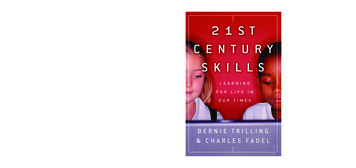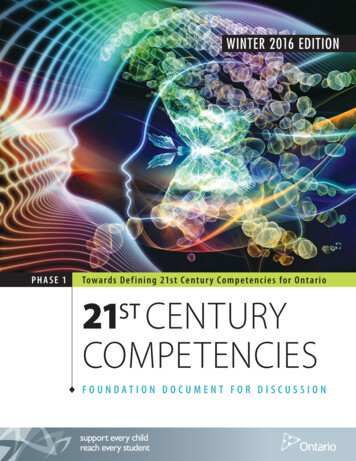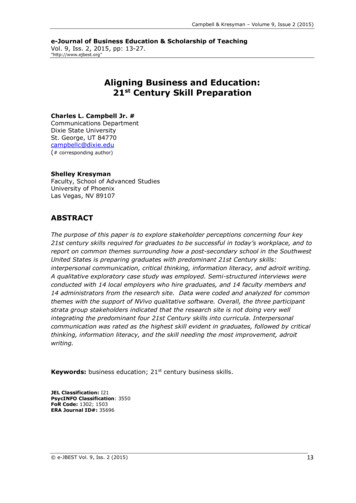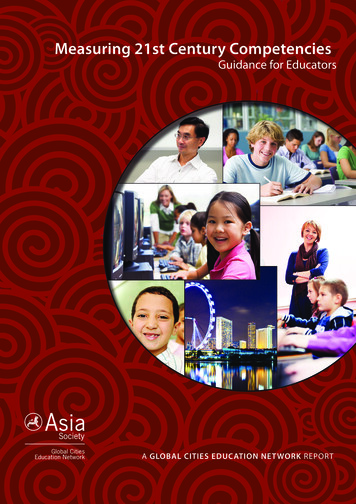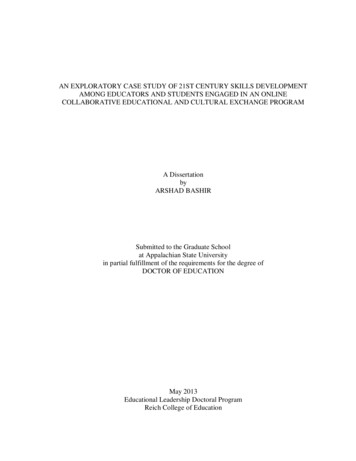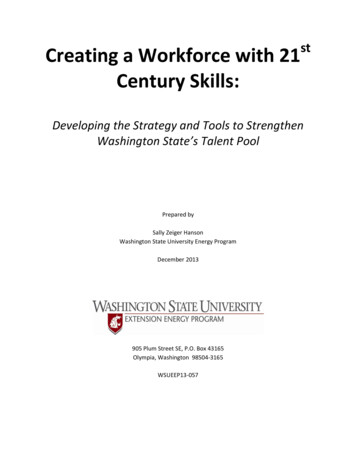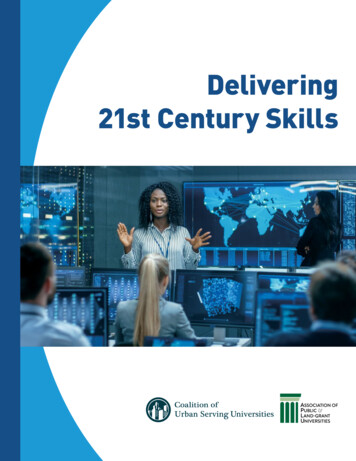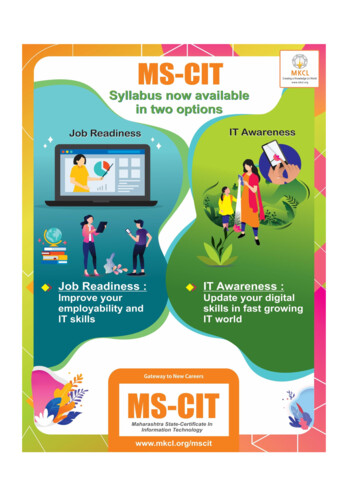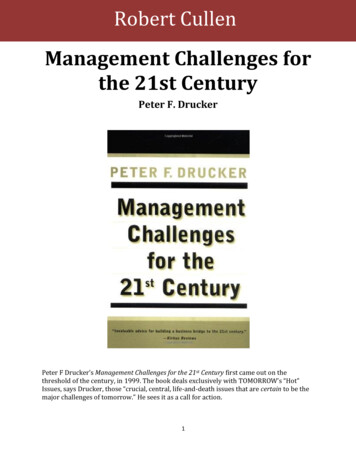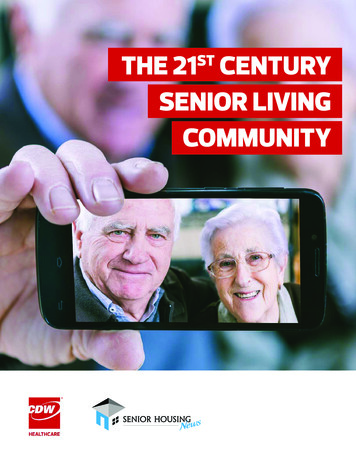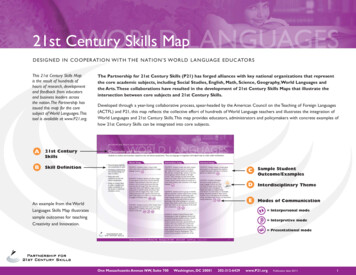
Transcription
21st Century Skills MapDES IGN ED IN COOPERATION W I TH T H E NATI O N' S WO RL D L A NG UAG E E D U C ATO R SThis 21st Century Skills Mapis the result of hundreds ofhours of research, developmentand feedback from educatorsand business leaders acrossthe nation. The Partnership hasissued this map for the coresubject of World Languages. Thistool is available at www.P21.org.A21st CenturySkillsBSkill DefinitionThe Partnership for 21st Century Skills (P21) has forged alliances with key national organizations that representthe core academic subjects, including Social Studies, English, Math, Science, Geography, World Languages andthe Arts. These collaborations have resulted in the development of 21st Century Skills Maps that illustrate theintersection between core subjects and 21st Century Skills.Developed through a year-long collaborative process, spear-headed by the American Council on the Teaching of Foreign Languages(ACTFL) and P21, this map reflects the collective effort of hundreds of World Language teachers and illustrates the integration ofWorld Languages and 21st Century Skills. This map provides educators, administrators and policymakers with concrete examples ofhow 21st Century Skills can be integrated into core subjects.C Sample StudentOutcome/ExamplesD Interdisciplinary ThemeEAn example from the WorldLanguages Skills Map illustratessample outcomes for teachingCreativity and Innovation.Modes of Communication Interpersonal mode Interpretive mode Presentational modeOne Massachusetts Avenue NW, Suite 700Washington, DC 20001202-312-6429www.P21.orgPublication date: 03/111
IntroductionIncreasingly global economies, a heightened needLearning other languages and understanding the culture of the people who speak them is a 21st Centuryfor national security, and changing demographicsskill that is vital to success in the global environment in which our students will live and work. In a 2006in the U.S. have increased attention to ourreport entitled, )HYGEXMSR JSV PSFEP 0IEHIVWLMT 8LI -QTSVXERGI SJ -RXIVREXMSREP 7XYHMIW country’s lack of language capability. Every callERH *SVIMKR 0ERKYEKIW JSV 9 7 )GSRSQMG ERH 2EXMSREP 7IGYVMX], the Committee for Economicto action to prepare our students for the 21stDevelopment (CED) stated “To confront the twenty-first century challenges to our economy and nationalCentury includes offering them the opportunitysecurity, our education system must be strengthened to increase the foreign language skills and culturalto learn languages other than English and increaseawareness of our students. America’s continued global leadership will depend on our students’ abilities totheir knowledge of other cultures. Yet the latestinteract with the world community both inside and outside our borders.” For college and career readiness,enrollment figures indicate that in 2007-08 onlyour students need to be proficient in other languages, regardless of whether they choose to transition directly18.5% of students in U.S. public schools K-12to the workforce or to post-secondary education.were enrolled in a language class.The language teaching community has reached strong consensus regarding the goals of a language program:Clearly, language education is critical to ourto develop students’ language proficiency* around modes of communicative competence reflecting real lifestudents’ success in the world of the future: acommunication. This is reflected in the Standards for Foreign Language Learning in the 21st Century in theworld that will insist upon their need to interactopening statement, “Language and communication are at the heart of the human experience.” The nationaleffectively with others who do not speak English.standards are undergirded by five goals (the 5 Cs) that focus language learning on:It is critically important that schools, elementarythrough post-secondary, offer our students thatCommunication: The ability to convey and receive messages based on the three modes ofopportunity to develop those skills.communication; interpersonal, or two-way interaction with someone else; interpretive, the ability tounderstand and interpret a one-way aural or written text; and presentational, the ability to presentinformation in either a written or oral format. These modes reflect how people communicate in real life.The examples included in the World Language Skills map reflect these modes of communication.* Language proficiency in a Latin program emphasizes the ability to interpretwritten Latin but uses the aural/oral skills to promote the interpretive ability.For American Sign Language classes, communicative competence focuses onsigned communication ability.Cultures: As the teaching of language and culture are inextricably intertwined, students learn to understandthe culture of the people who speak the target language through learning about the products and practices ofthe culture and how those relate to the perspectives of the people of that culture.One Massachusetts Avenue NW, Suite 700Washington, DC 20001202-312-6429www.P21.orgPublication date: 03/112
Introduction (continued)Connections: Students are able to access knowledge in other disciplines through the targetLanguage education not only contributes to students’language and to reinforce concepts already learned in these disciplines in the language classroom.career and college readiness, it also helps developthe individual as language learners take on a newComparisons: As students learn a new language and culture, they develop insight into their ownand more invigorating view of the world. They comelanguage and culture, thus providing them with a deeper understanding of how language works andto understand the world better because of theirhow cultures reflect the perspectives, practices, and products of the people who speak that language.knowledge of speakers of another language – ofpeople who share many of the same hopes andCommunities: Language learning becomes even more purposeful for students when theydreams for their future. While perspectives maysee the application beyond the classroom. With today’s communication technologies, languagediffer among speakers of different languages, moreclassrooms can bring the world to the students, as teachers provide opportunities for students tosimilarities exist than we might imagine. However, ituse the language beyond the confines of their classroom walls.is only through knowing the language of others thatAs communicative competence becomes a more focused goal for classrooms across the U.S.,student progress in developing higher levels of proficiency becomes increasingly important. Inorder to prepare students adequately for the work force as well as post-secondary education,we can truly understand how they view the world.And this is what makes the language student a 21stCentury skilled learner!students need a long sequence of well-articulated language learning that begins in elementaryschool. If students are expected to be ready to use their languages for professional purposes uponentering the work force, they need to leave the K-12 educational system with an Advanced level ofproficiency and the post-secondary world at the Superior level. Meeting these levels of proficiencyrequires that students begin early and continue in an extended sequence of language learning thatbuilds sequentially from one level to another.One Massachusetts Avenue NW, Suite 700Washington, DC 20001202-312-6429www.P21.orgPublication date: 03/113
Introduction (continued)Then and NowThe language classroom in the U.S. hasbeen transformed in the last 20 yearsto reflect an increasing emphasis ondeveloping students’ communicativeIN THE PASTTODAYStudents learned about the language (grammar)Students learn to use the languageTeacher-centered classLearner-centered with teacher as facilitator/collaboratorFocused on isolated skills (listening, speaking,reading, and writing)Focus on the three modes: interpersonal, interpretive,and presentationalCoverage of a textbookBackward design focusing on the end goalUsing the textbook as the curriculumUse of thematic units and authentic resourcesEmphasis on teacher as presenter/lecturerEmphasis on learner as “doer” and “creator”Isolated cultural “factoids”Emphasis on the relationship among the perspectives,practices, and products of the cultureUse of technology as a “cool tool”Integrating technology into instruction to enhance learningOnly teaching languageUsing language as the vehicle to teach academic contentSame instruction for all studentsDifferentiating instruction to meet individual needsSynthetic situations from textbookPersonalized real world tasksConfining language learning to the classroomSeeking opportunities for learners to use languagebeyond the classroomTesting to find out what students don’t knowAssessing to find out what students can doOnly the teacher knows criteria for gradingStudents know and understand criteria on how they will beassessed by reviewing the task rubricStudents “turn in” work only for the teacherLearners create to “share and publish” to audiencesmore than just the teacher.competence. Unlike the classroomof yesteryear that required studentsto know a great deal of informationabout the language but did not havean expectation of language use, today’sclassroom is about teaching languages sothat students use them to communicatewith native speakers of the language.This is what prepares them to use theirlanguage learning as a 21st Century Skill.Following is a chart comparing howlanguage classrooms looked in the pastcompared to today.One Massachusetts Avenue NW, Suite 700Washington, DC 20001202-312-6429www.P21.orgPublication date: 03/114
Introduction (continued)INTERDISCIPLINARY THEMESMODES OF COMMUNICATIONGlobal Awareness. Language education and cultural understanding are at the heartof developing global awareness for students. In order to understand and address globalissues, it is important to understand the perspectives on the world that speakers of otherlanguages bring to the table. By learning other languages, students develop respect and openness tothose whose culture, religion, and views on the world may be different. Language students are able tointeract with students from the target language in order to discuss issues and reach solutions.Interpersonal mode.Interpersonal mode is active oral orwritten communication in which theparticipants negotiate meaning to makesure that their message is understood.Financial, Economic, Business and Entrepreneurial Literacy.Students in language classes learn about financial and economic issues in the targetlanguage culture(s) and are able to compare and contrast with those of the United States.According to the Committee for Economic Development (CED), “ cultural competenceand foreign language skills can prove invaluable when working on global business teams or negotiatingwith overseas clients.” In addition, the changing demographics in the U.S. make language capability arequisite for interacting with non-English speaking communities domestically as well as internationally.Those who are able to communicate with others in their native language will naturally feel moreempowered to negotiate with those around the world as they engage in entrepreneurial activities.Interpretive mode.Interpretive mode is the ability to listen toor read a text and interpret the meaning.Presentational mode.Presentational mode is written or oralcommunication in which the presentermust take into account the impacton the audience since this is one-waycommunication with limited opportunityfor feedback.Civic Literacy. Language learners become aware of the judicial, legislative and governmentfunctions of the target language country(ies) and are able to compare and contrast those with the civilliberties and responsibilities in the U.S. Because they can communicate in the target language, they areable to engage in discussions with other students and participate in activities in which they discuss civiclife in their respective countries.Health Literacy. Language learners are engaged in a value-added activity as they canaddress global health and environmental issues in the target language and understand materialsthat were written for native speakers of that language. They have access to informationbecause they can understand the language and can thus engage in global discussions on health,environmental, and public safety issues, and can prepare for careers in these fields.One Massachusetts Avenue NW, Suite 700Washington, DC 20001202-312-6429www.P21.orgPublication date: 03/115
INFORMATION, MEDIA AND TECHNOLOGY SKILLSCommunicationStudents as effective communicators use languages to engage in meaningful conversation, to understand and interpret spoken language and written text,and to present information, concepts, and ideas. Articulate thoughts andideas effectively using oral,written and nonverbalcommunication skills ina variety of forms andcontexts. Use communication for arange of purposes (e.g. toinform, instruct, motivate,and persuade). Communicate effectivelyin diverse multi-lingualenvironments.Novice RangeIntermediate RangeAdvanced RangeOUTCOME: Students in the novice range areable to comprehend and use short memorizedphrases and sentences.OUTCOME: Students in the intermediate rangeare able to express their own thoughts, providedescriptions, and communicate about familiartopics using sentences and strings of sentences.They comprehend general concepts and messagesabout familiar and occasionally unfamiliar topics.They can ask questions on familiar topics.OUTCOME: Students in the advanced rangeare able to narrate and describe using connectedsentences and paragraphs in at least three timeframes when discussing topics of personal, school,and community interest and can comprehendmain ideas and significant details regarding avariety of topics.Students reach this proficiency range generallyafter 4-5 years in a language program dependingon its intensity.Students generally reach this proficiency rangeafter participating in a well-articulated standardsbased K-12 language program.EXAMPLE: Students prepare anelectronic infobrief in the targetlanguage that provides informationabout daily life in the United Statesto prepare for a visit from an e-palfrom the target language country.EXAMPLE: As part of a unit on communitydevelopment, students communicate with aPeace Corps volunteer, community activist, orlocal leader who is fluent in the target languageand has field work experience. Students exchangeinformation as it relates to the work/projectsbeing undertaken in that country or locally.Areas of focus may include: agriculture, business,education, health, and the environment.This proficiency level reflects the beginningstages of language learning which could be at theelementary, middle, or high school levels.EXAMPLE: Students listen to authentic audioclips featuring native speakers describing an event,and can match the oral description to a picture,or put pictures in the order of the sequence ofevents as described.EXAMPLE: Students read severalauthentic menus and identify whichwould be appropriate for differentpeople based on likes/dislikes andspecial dietary needs.EXAMPLE: Students interview family membersto find out the ingredients in their favorite recipes.They make a list of the ingredients and thencompile a book of popular recipes in the targetlanguage.EXAMPLE: Students browse the website of acurrent popular magazine in a target languagecountry. They identify the emotions of the peoplein the photo based on their interpretation of visualand linguistic cues and then discuss their findingswith their classmates.One Massachusetts Avenue NW, Suite 700EXAMPLE: Students work in groups to researchlocal restaurants and produce restaurant reviewsin the target language. They map the restaurantson internet maps and give directions to therestaurants in the language.EXAMPLE: Students write a short emaildescribing their school's technology, its use inclass, and appropriate-use guidelines. They askstudents of a teacher in a target language countryto describe the same at their school, and thendiscuss the similarities and differences.Washington, DC 20001202-312-6429www.P21.orgEXAMPLE: In a simulated trainingexercise, students will roleplay scenarios between airlinepassengers and flight attendantson a flight to a target languagecountry. Possible scenarios include:passengers who (a) are concernedabout missing their connecting flight (b) havefood allergies or (c) are becoming ill.Publication date: 03/116
INFORMATION, MEDIA AND TECHNOLOGY SKILLSCommunication (continued)Students as effective communicators use languages to engage in meaningful conversation, to understand and interpret spoken language and written text,and to present information, concepts, and ideas.Novice RangeOne Massachusetts Avenue NW, Suite 700Intermediate RangeAdvanced RangeEXAMPLE: Students practice the use ofcircumlocution and other communicativestrategies with a group of community volunteerswho are fluent in the target language, and invitethem to visit the school once per month for aninformal conversation hour.EXAMPLE: The senior class plans a real orsimulated senior trip to a country/countriesthat speaks the target language. Studentsinvestigate two potential locations, one a verychallenging situation (because of local conflict ornatural disaster) and the other a very appealingdestination and give a presentation outliningarguments why the class should go to one andnot the other.Washington, DC 20001202-312-6429www.P21.orgPublication date: 03/117
INFORMATION, MEDIA AND TECHNOLOGY SKILLSCollaborationStudents as collaborators use their native and acquired languages to learn from and work cooperatively across cultures with global team members,sharing responsibility and making necessary compromises while working toward a common goal. Articulating thoughtsand ideas clearly andeffectively throughspeaking and writing Demonstrating the abilityto work effectively withdiverse teamsNovice RangeIntermediate RangeAdvanced RangeEXAMPLE: Students team with another classin a target language country to identify andcompare endangered species in both countries,and collaborate to produce a multi-mediainformational presentation for their peers usingbasic information in the target language.EXAMPLE: Students work in teams ofclassmates or team with another class in a targetlanguage country to research and analyze costsfor a summer study abroad program in a varietyof possible destinations in one or more targetlanguage countries. Students share responsibilityfor looking up certain information, exchangeinformation, and complete a cost-benefit analysisto decide the best place to study based on theavailable budget.EXAMPLE: In small groups, students designa product and develop a marketing campaignfor this product to sell it to consumers in atarget country. Students present their marketingcampaigns to students in the target languagecountry via target language media outlets. Exercising flexibilityand willingness tobe helpful in makingnecessary compromisesto accomplish a commongoalEXAMPLE: During career weekat school, students research jobads in the target language onInternet databases (or in printmedia) to locate jobs in whichthey are interested. They choose one each andprepare themselves for an interview by writinga résumé and cover letter and submitting itto classmates. Students are placed into smallgroups (interview teams) and must review thedocuments of prospective applicants. Candidatesparticipate in an oral interview in a panel format.Panelists prepare questions for their colleaguesand the interviewees must explain their skillsand why they should get the job. Students "rate"candidates on a rubric that they have designed asa team. Assuming sharedresponsibility forcollaborative workOne Massachusetts Avenue NW, Suite 700Washington, DC 20001202-312-6429www.P21.orgPublication date: 03/118
INFORMATION, MEDIA AND TECHNOLOGY SKILLSCritical Thinking and Problem SolvingStudents as inquirers frame, analyze, and synthesize information as well as negotiate meaning across language and culture in order to explore problems and issuesfrom their own and different perspectives. Exercising soundreasoning inunderstanding Making complex choicesand decisions Understanding theinterconnections amongsystems Identifying and askingsignificant questions thatclarify various points ofview and lead to bettersolutions Framing, analyzing andsynthesizing informationin order to solve problemsand answer questionsNovice RangeIntermediate RangeAdvanced RangeEXAMPLE: Students develop asurvey to investigate the eatinghabits of the class, interviewstudents, analyze the data in termsof good nutritional habits, synthesizeit into a graph, and create a document to share theresults with others.EXAMPLE: Students explore an environmentalissue in a target language country with a group ofpeers from that country. Together they proposesolutions that are environmentally safe.EXAMPLE: Students investigate animmigration issue in the US and a targetlanguage country, analyze and synthesize theinformation, and propose a solution in the formof a letter to the editor.EXAMPLE: With the job titleomitted, students read variousjob/career ads and then matchthe appropriate job title to the ad.Students are divided into groups. Eachgroup is asked to investigate 3-5 different career/job sites and identify the jobs and careers thatare in high demand in a particular city, region, orcountry. Students present their findings to theclass.EXAMPLE: Students examine a variety ofresumes from Internet sites. They then identifypossible jobs/careers that the resume writer(s)might seek. Using an Internet resume site,students complete a template for a job/careerthey might have at some time in the future,and write a cover letter in which they "applyfor" a prospective job. Students organize a classjob/career fair, alternately playing the roles ofinterviewer and interviewee.EXAMPLE: Using a word cloud generator, presentstudents with a graphic visualization of a text(poem, song, rhyme, fable) and have them predict(whole class, groups or pairs) the main theme, ideaor key concepts.One Massachusetts Avenue NW, Suite 700Washington, DC 20001202-312-6429www.P21.orgPublication date: 03/119
INFORMATION, MEDIA AND TECHNOLOGY SKILLSCreativity and InnovationStudents as creators and innovators respond to new and diverse perspectives. They use language in imaginative and original ways to make useful contributions. Demonstrating originalityand inventiveness in work Developing, implementingand communicating newideas to others Being open andresponsive to new anddiverse perspectives Acting on creative ideasto make a tangible anduseful contribution tothe domain in which theinnovation occursNovice RangeIntermediate RangeAdvanced RangeEXAMPLE: Students create a song to helpothers learn about endangered species in a targetlanguage country.EXAMPLE: Students create raps and/or poemsreflecting a perspective, such as a “coming ofage” event in the target culture and compare thiswith the “coming of age” process in the U.S. suchas getting a driver’s license or the right to vote.These examples are then shared with peers inthe target culture who have completed a similarproject and the results are shared on a socialmedia website with comments in the targetlanguage.EXAMPLE: Students design a unique game(board game or video game) that exploresmultiple alternative scenarios. to introducegamers to a global issue.EXAMPLE: Students identify and select imagesof importance to them from a service learningsituation. They brainstorm with their peers toproduce a list of words and phrases that theyassociate with the image. They then share theimage with others from different target culturesasking them to identify words and phrases theyassociate with the images. They create a multimedia presentation that captures what they andothers have shared in an effort to convince othersto engage in volunteer work.EXAMPLE: Students browse online recipes fromtarget language sites and work in pairs to changeingredients to a healthier alternative, which theypresent to the class.EXAMPLE: Students work in groups to identifydifferent volunteer vacation opportunities aroundthe world. They connect via technology withtarget language speakers who work with theseprojects to learn more and to find out what atypical day is like when working on a volunteerproject. They create a multi-media presentation toshare with others on the importance of the workthat is being done.EXAMPLE: Students investigatealternative energy projects in atarget language country (ex: SolarDecathlon Europe) and use ideasgleaned from their investigation todesign and explain an original designof an electric car, solar house, or renewableenergy alternative specific to their school.Students vote on the best use of renewableenergy and defend their choice in an alternativeenergy publication.EXAMPLE: Students rework a familiar story,such as Goldilocks and the Three Bears so thatit takes place in a target language culture andincorporates elements of the target culture.Students then retell the story with visuals usingnarrated presentation or other software. Studentsshare and discuss stories with e-pals.One Massachusetts Avenue NW, Suite 700Washington, DC 20001202-312-6429www.P21.orgPublication date: 03/1110
INFORMATION, MEDIA AND TECHNOLOGY SKILLSCreativity and Innovation (continued)Students as creators and innovators respond to new and diverse perspectives. They use language in imaginative and original ways to make useful contributions.Novice RangeIntermediate RangeAdvanced RangeEXAMPLE: Student Created Museum: afterdeciding upon a topic of significant cultural and/or historical interest, students propose researchquestions, divide themselves into teams toconduct research and locate representations ofartifacts. Then they compile the research andartifacts into a series of museum exhibits forwhich they serve as the docents. Members of thetarget language community serve as consultantson the project during its development. Thestudent docents prepare a virtual tour of themuseum to share with their peers both withinthe school community and in the target languagecountry.One Massachusetts Avenue NW, Suite 700Washington, DC 20001202-312-6429www.P21.orgPublication date: 03/1111
INFORMATION, MEDIA AND TECHNOLOGY SKILLSInformation LiteracyStudents as informed global citizens access, manage, and effectively use culturally authentic sources in ethical and legal ways. Accessing informationefficiently and effectively,evaluating informationcritically and competentlyand using informationaccurately and creativelyfor the issue or problemat hand Possessing a fundamentalunderstanding of theethical/legal issuessurrounding the accessand use of informationNovice RangeIntermediate RangeAdvanced RangeEXAMPLE: Students find a foodpyramid or similar nutritional guideonline from a target languagecountry and read it to understandhealthy eating in that country. Theygo shopping on a target languagewebsite, select foods that represent a healthy mealaccording to the nutritional guidelines and createa menu for a week. They then have a conversationwith a person from the target language country toverify their understanding of the food pyramid.EXAMPLE: Students access music in the targetlanguage and develop a website to showcase thevarious musical genres following legal and ethicalguidelines for posting and sharing music. Theycompare and contrast the laws for posting andsharing music in the U.S. and the target languagecountry.EXAMPLE: Students accessinformation in the target languageonline related to children’s rightsand labor laws, and engage in adebate related to this issue usingan on-line platform to connect withspeakers in a target language country.EXAMPLE: Students use varioustarget language media to gatherinformation about target culturePresidential election candidatesand create a digital poster aboutthe candidate of their choice. Theyalso identify examples of propaganda found in thecourse of their research. Mock class voting willtake place prior to the actual election, and resultswill be displayed in a chart.EXAMPLE: Students use varioustarget language media to followtarget language Presidentialcampaign promotions (ads,commercials, etc.) and create ashort promotion for their chosencandidate and his/her platform or "cause" usingvideo or podcasts Students identify differences inadvertising techniques, comparing and contrastingcandidate promotions with those used for recentU.S. elections. Mock class voting will take placeprior to the actual election, and results will becompared and analyzed in an article for thestudents’ school newspaper and the newspaperof the students’ sister school.EXAMPLE: Students research activities of variousUnited Nations theme days (for example, WorldFood Day, World AIDS Day) on websites from theUnited Nations and target language countries. Eachstudent (or student team) selects a participatingcountry and develops a digital poster of itsactivities related to the celebration.EXAMPLE: Students work in groups of 3-4 toprepare a live news broadcast using websitesfrom various news sites. Students will useinformation on local, regional, and world newsfrom a target language website to produce anews broadcast.One Massachusetts Avenue NW, Suite 700Washington, DC 20001202-312-6429www.P21.orgPublication date: 03/1112
INFORMATION, MEDIA AND TECHNOLOGY SKILLSMedia LiteracyStudents as active global citizens evaluate authentic sources to understand how media reflect and influence language and culture. Understanding howmedia messages areconstructed, for whatpurposes and using whichtools, characteristics andconventions Examining how individualsinterpret messagesdifferently, how valuesand points of view areincluded or excluded andhow media can influencebeliefs and behaviorsNovice RangeIntermediate RangeAdvanced RangeEXAMPL
For American Sign Language classes, communicative competence focuses on signed communication ability. Learning other languages and understanding the culture of the people who speak them is a 21st Century skill that is vital to success in the global environment in which our s
